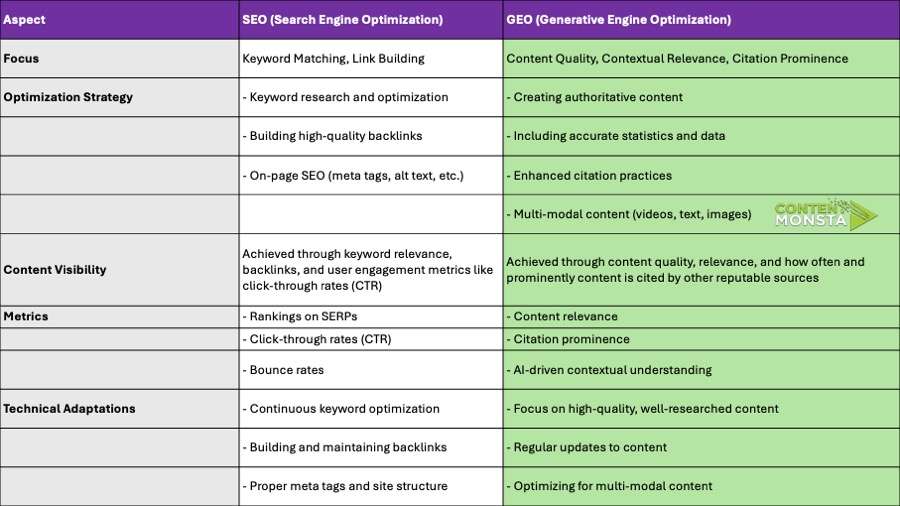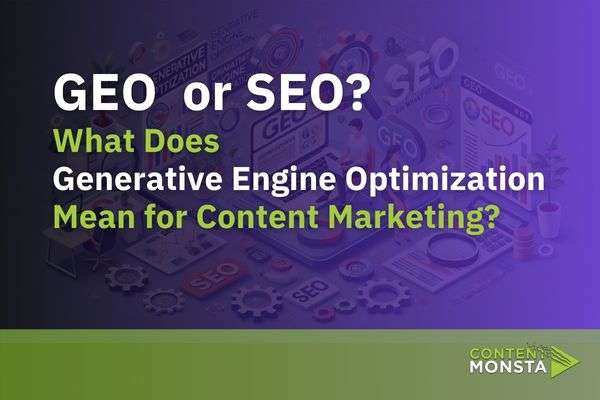Generative Engine Optimization (GEO) might soon make traditional SEO techniques obsolete with the rise of AI-driven search engines. As technology advances, the landscape of digital search is evolving rapidly. The introduction of generative AI in search engines is a seismic shift that could change how we optimize our content forever. If you’ve been relying solely on keyword optimization and backlinks, it’s time to rethink your strategy. Welcome to the era of GEO, where quality and context are the new kings.
The shift from traditional SEO to Generative Engine Optimization (GEO) is transforming the way we approach content optimization for search engines. As generative AI becomes more prevalent, understanding and adapting to GEO will be crucial for content creators and marketers to maintain and enhance their online visibility.
This article will explore the concept of Generative Engine Optimization (GEO), compare it with traditional Search Engine Optimization (SEO), and discuss its impact on content marketing.
We will begin by defining GEO by explaining how it works. You’ll learn about the mechanics of generative engines, such as Google’s Search Generative Experience (SGE), Perplexity.ai and Open AI’s SearchGPT , which use advanced AI to synthesize information and generate comprehensive responses. This section will help you understand the shift from traditional keyword-based optimization to a focus on content quality and relevance.

Next, we will compare GEO with traditional SEO. This section will highlight the differences in optimization strategies, metrics, and content visibility. While SEO focuses on improving rankings through keywords and backlinks, GEO emphasizes enhancing content to ensure it is effectively used by AI-driven search engines. Understanding these differences will help you adapt your strategies to maintain and enhance your online presence.
Finally, we will discuss the implications of GEO for content marketing. You’ll gain insights into the strategic shifts required to balance traditional SEO with new GEO methods. We will also predict future trends and provide practical recommendations for content marketers to optimize their content for both SEO and GEO, ensuring maximum visibility in the evolving digital landscape.
Understanding Generative Engine Optimization (GEO)
Definition and Concept
Generative Engine Optimization (GEO) is a new approach to optimizing content for search engines that utilize advanced AI technologies. Unlike traditional Search Engine Optimization (SEO), which focuses on improving website rankings through keyword optimization, backlinks, and meta tags, GEO is designed to enhance content visibility within AI-generated responses.
How GEO Differs from Traditional SEO
Traditional SEO aims to improve a website’s position on search engine results pages (SERPs) by optimizing for specific keywords and building authoritative links. The primary goal is to increase organic traffic by appearing higher in the search rankings. Techniques include keyword research, on-page optimization, and link building. Success is often measured by metrics such as click-through rates (CTR), keyword rankings, and traffic volume.
GEO, on the other hand, focuses on making content more visible and relevant in the context of generative AI responses. Generative engines like Google’s Search Generative Experience (SGE) do not simply list links. Instead, they synthesize information from multiple sources to generate comprehensive answers. This means that content must be optimized for keywords as well as for quality, relevance, and presentation to ensure it is effectively used by AI to provide accurate and valuable responses.
The Role of Large Language Models (LLMs)
At the heart of GEO are large language models (LLMs), such as those used in Google’s SGE. These models are trained on vast amounts of data and are capable of understanding and generating human-like text. They can interpret complex queries and provide detailed answers by synthesizing information from various sources.
For example, when a user queries, “What is remote video production and what steps does it require?” a generative engine powered by an LLM can break down the question, search relevant databases, and generate a nuanced answer that includes key information about steps.

LLMs enhance the search experience by:
- Understanding Context: LLMs can grasp the context of a query and provide more accurate answers than traditional keyword-based searches.
- Generating Comprehensive Responses: They can pull information from multiple sources, ensuring that the response is thorough and informative.
- Improving User Experience: By generating answers that are easy to understand and relevant to the user’s specific query, LLMs make the search experience more intuitive and satisfying.
GEO represents a significant shift from traditional SEO. It leverages the power of large language models to ensure content is not only found but effectively utilized in AI-generated responses. This new approach requires content creators to focus on quality, relevance, and presentation, adapting to the evolving landscape of digital search.
How Generative Engines Work
Generative engines, such as Google’s Search Generative Experience (SGE), operate fundamentally differently from traditional search engines. Traditional search engines primarily rank and list websites based on keyword relevance and authority. In contrast, generative engines use advanced AI models to understand and generate human-like responses, synthesizing information from various sources to provide comprehensive answers.
Gathering and Synthesizing Information
- Query Interpretation
- When a user inputs a query, generative engines like SGE first interpret the question using large language models (LLMs). These models are designed to understand the nuances and context of the query, which allows them to go beyond simple keyword matching.
- Information Retrieval
- Once the query is understood, the engine searches a vast database of indexed content. This includes articles, research papers, websites, and other relevant documents. The engine retrieves documents that contain information pertinent to the query.
- Content Synthesis
- The generative engine then synthesizes the retrieved information to generate a cohesive and comprehensive response. This involves:
- Summarization: Condensing large amounts of information into a concise answer.
- Attribution: Including citations and references to the original sources of information.
- Relevance Filtering: Ensuring the most relevant and accurate information is included in the final response.
- The generative engine then synthesizes the retrieved information to generate a cohesive and comprehensive response. This involves:
- Response Generation
- The final step is generating a natural language response. The engine constructs a human-like answer that directly addresses the user’s query, often providing a summary, context, and suggested follow-up questions or next steps. This response is designed to be easily understandable and immediately useful to the user.
Example: Google’s Search Generative Experience (SGE)
SGE represents a prime example of how generative engines work. When a user asks a question, SGE processes the query through several stages:
- AI Snapshot: SGE provides an AI-generated snapshot of key information relevant to the query. This snapshot includes a summary of important points and direct links to further information.
- Contextual Continuity: If the user asks follow-up questions, SGE maintains the context from the previous queries, allowing for a more natural and conversational interaction.
- Comprehensive Answers: SGE generates answers that combine information from multiple sources, ensuring that the user receives a well-rounded response that addresses the query from various angles.
In essence, generative engines like SGE transform the search experience by leveraging advanced AI to provide detailed, context-rich answers. This marks a significant departure from the list-based results of traditional search engines, highlighting the need for new optimization strategies like Generative Engine Optimization (GEO).

Let Me Search For You
GEO Challenges for Content Creators
Adapting to New Technology
Content creators face significant challenges as they adapt to the new paradigm of Generative Engine Optimization (GEO). Traditional SEO strategies have been well-defined and understood for years, focusing on keyword optimization, link building, and meta tags. However, the shift to GEO requires a new set of skills and understanding. Content creators must now focus on ensuring their content is not just keyword-rich but also contextually relevant and high-quality to be effectively utilized by AI-driven search engines like Google’s Search Generative Experience (SGE).
The Black-Box Nature of Generative Engines
One of the most significant difficulties content creators face is the black-box nature of generative engines. Unlike traditional search engines, where the factors influencing rankings are somewhat transparent and can be optimized for, generative engines operate in a more opaque manner. These engines use complex algorithms and large language models to synthesize responses, and the exact criteria they use to determine which content to include in their answers are not always clear. This lack of transparency makes it challenging for content creators to understand how to optimize their content effectively.
Lack of Control Over Content Display
In traditional SEO, content creators have a reasonable degree of control over how their content is presented in search results. They can influence titles, meta descriptions, and even rich snippets to attract clicks. However, with generative engines, this control diminishes significantly. The AI synthesizes information from various sources and presents it in a way that it deems most relevant, often without displaying the original context or giving full credit to the source. This can lead to situations where the content is used and summarized without driving traffic back to the original site, which can impact visibility and revenue for content creators.
Example: Google’s Search Generative Experience (SGE)
SGE exemplifies these challenges. When a user asks a complex question, SGE generates a detailed response by pulling information from multiple sources. While this provides a comprehensive answer to the user, it often means that the original sources are not directly credited in a way that drives significant traffic back to them. This shift necessitates new strategies for content creators to ensure their work is still visible and valuable in this new search landscape.
In summary, adapting to GEO requires content creators to rethink their strategies and focus more on producing high-quality, contextually rich content. They must navigate the challenges posed by the black-box nature of generative engines and the reduced control over how their content is displayed. Embracing these changes and understanding the new optimization techniques will be crucial for maintaining visibility and effectiveness in the evolving digital landscape.
Comparing GEO and SEO Optimization

Optimization Focus
SEO: Keyword Matching and Link Building
Traditional Search Engine Optimization (SEO) revolves around improving a website’s ranking on search engine results pages (SERPs). The primary focus areas include keyword matching and link building:
- Keyword Matching
- SEO strategies heavily rely on identifying and incorporating relevant keywords into website content. This involves researching the terms users are most likely to search for and ensuring these keywords are strategically placed within the content, titles, meta descriptions, and headers.
- The goal is to signal to search engines that the content is highly relevant to specific queries, thereby improving its chances of ranking higher on SERPs.
- Link Building
- Another critical component of SEO is building high-quality backlinks from authoritative websites. These links act as endorsements, signaling to search engines that the content is credible and valuable.
- The more high-quality backlinks a page has, the higher it is likely to rank, as search engines consider these links as votes of confidence.
GEO: Content Quality and Presentation
Generative Engine Optimization (GEO) shifts the focus from keywords and backlinks to content quality and presentation. This approach is crucial for ensuring content is effectively used by AI-driven search engines, which prioritize providing comprehensive and contextually relevant answers to users’ queries:
- Content Quality
- GEO emphasizes creating high-quality, authoritative content. This involves ensuring the content is well-researched, informative, and valuable to the reader.
- High-quality content is more likely to be selected and synthesized by generative engines because it provides reliable information that can be integrated into AI-generated responses.
- Presentation
- Presentation refers to how the content is structured and presented. This includes using clear headings, concise language, and logical organization to make the content easily digestible.
- Well-presented content helps generative engines quickly extract and synthesize the necessary information to generate accurate and useful responses.
Different Metrics Used in GEO
GEO employs different metrics compared to traditional SEO to measure content effectiveness:
- Content Relevance
- Instead of focusing solely on keyword density, GEO evaluates the overall relevance of the content to the query. This involves understanding the context and ensuring the content provides a comprehensive answer to potential user questions.
- Content relevance is judged based on how well the information aligns with the intent behind user queries and how effectively it addresses the topic at hand.
- Citation Prominence
- In GEO, citation prominence becomes a crucial metric. This refers to how often and prominently the content is cited or referenced by other sources.
- Generative engines value content that is frequently cited by reputable sources because it indicates credibility and authority. Ensuring your content is well-cited can significantly enhance its visibility in AI-generated responses.
By focusing on content quality and presentation, GEO aligns with the evolving capabilities of generative engines. These engines aim to provide users with accurate, context-rich answers rather than listing links. Understanding and adapting to these new optimization metrics is essential for maintaining and improving content visibility in the age of AI-driven search.

Content Visibility
More Than Just Text… Video, Images, and more.
Content Visibility
Visibility in SEO
In traditional Search Engine Optimization (SEO), visibility is primarily achieved through a linear ranking system. This system relies on several key factors:
- Keyword Relevance
- Websites are ranked based on how well they match the keywords used in search queries. The more relevant the keywords, the higher the likelihood of appearing at the top of search engine results pages (SERPs).
- Backlinks
- The number and quality of backlinks to a website are crucial. Backlinks from authoritative and reputable sources signal to search engines that the content is trustworthy and valuable.
- Technical SEO
- Proper use of meta tags, alt text, and a well-structured website enhance a site’s visibility. These elements help search engines crawl and index the site more effectively.
- User Engagement
- Metrics such as click-through rates (CTR), bounce rates, and time spent on the page also influence visibility. Engaging content that keeps users on the page longer can boost rankings.
Visibility in GEO
Generative Engine Optimization (GEO) adopts a multi-faceted approach to achieving content visibility, reflecting the complex nature of AI-driven search engines:
- Content Relevance
- Instead of focusing solely on keyword matching, GEO evaluates the overall relevance of the content to the user’s query. This includes the quality of the information, how well it answers the query, and its contextual accuracy.
- Citation Prominence
- Generative engines prioritize content that is frequently cited by other reputable sources. Being referenced by authoritative sites indicates that the content is credible and valuable, which enhances its visibility in AI-generated responses.
- Content Quality and Authority
- High-quality, authoritative content is more likely to be used by generative engines. This involves providing detailed, accurate, and well-researched information that adds real value to the reader.
- Presentation and Structure
- Well-structured content with clear headings, concise language, and logical flow helps generative engines extract and synthesize information more effectively. This improves the chances of the content being included in AI-generated responses.
Multi-faceted Approach of GEO
The approach to visibility in GEO is multi-dimensional, reflecting the sophisticated capabilities of generative engines:
- Contextual Understanding
- Generative engines use large language models (LLMs) to understand the context of user queries and the content itself. This enables them to provide nuanced and contextually relevant answers rather than just listing links based on keyword matches.
- Dynamic Content Utilization
- Instead of a static ranking system, generative engines dynamically generate responses by synthesizing information from multiple sources. This means that content is evaluated and utilized based on its relevance and quality in real-time.
- User Intent and Satisfaction
- GEO prioritizes content that best meets the user’s intent and provides comprehensive answers. The focus is on user satisfaction, with the engine aiming to deliver the most useful and accurate information possible.
Contrast to Linear Ranking in SEO
In traditional SEO, visibility is achieved through a more straightforward, linear ranking system based on keyword relevance, backlinks, and user engagement metrics. This system works well for listing links but lacks the depth and contextual understanding required for more complex queries.
GEO, with its multi-faceted approach, evaluates content on several fronts:
- Relevance to Query: Ensuring the content directly addresses the user’s question.
- Authority and Credibility: Content that is well-cited and from reputable sources.
- Quality and Presentation: High-quality, well-structured content that is easy for AI to process and synthesize.
By incorporating these elements, GEO provides a more comprehensive and user-centric approach to content visibility, ensuring that users receive detailed and relevant answers to their queries. This evolution from a linear to a multi-dimensional system marks a significant shift in how content is optimized and discovered in the digital landscape.
Technical Adaptations
Evolution of Traditional SEO Practices
To stay relevant in the age of Generative Engine Optimization (GEO), traditional SEO practices must evolve. This evolution involves shifting from a focus on keyword density and backlinks to prioritizing content quality, contextual relevance, and authority. Here are some key areas where traditional SEO practices need to adapt:
- Content Creation
- Traditional SEO: Emphasizes incorporating high-volume keywords and creating content around these terms to rank higher in search results.
- GEO Adaptation: Focuses on creating authoritative content that provides in-depth and accurate information. This involves producing content that is not only keyword-optimized but also comprehensive, well-researched, and valuable to the reader. High-quality content is more likely to be recognized and utilized by generative engines.
- Inclusion of Statistics and Data
- Traditional SEO: Often includes basic data and statistics to support content and improve credibility.
- GEO Adaptation: Prioritizes the inclusion of detailed and accurate statistics and data to enhance content authority. Generative engines favor content that provides concrete evidence and reliable information, making it essential to incorporate up-to-date and relevant statistics.
- Enhanced Citations and References
- Traditional SEO: Typically uses hyperlinks to reputable sources to build credibility and authority.
- GEO Adaptation: Requires more robust citation practices. Including well-documented sources and clear attributions enhances the content’s credibility. Generative engines value content that is frequently cited by authoritative sources, which increases the likelihood of the content being included in AI-generated responses.
Examples of Effective GEO Methods
- Authoritative Content Creation
- Create content that is thorough, well-researched, and provides expert insights. This involves collaborating with industry experts, conducting original research, and producing content that stands out as a reliable source of information.
- Example: A detailed guide on digital marketing strategies that includes expert opinions, case studies, and actionable tips. This type of content not only attracts readers but also gains recognition from generative engines for its depth and quality.
- Inclusion of Statistics and Data
- Incorporate relevant and current statistics to support your content. Use data from reputable sources and present it in a clear and easily understandable format.
- Example: An article on the impact of social media on consumer behavior that includes recent statistics from industry reports, surveys, and studies. Visual representations like charts and graphs can also enhance the presentation of data, making it more appealing to both readers and AI engines.
- Enhanced Citations
- Ensure all information is properly cited with references to authoritative sources. Use academic-style citations where appropriate and provide clear attributions.
- Example: A research paper on the benefits of content marketing that cites studies from academic journals, industry reports, and reputable publications. Including hyperlinks to original sources and a bibliography at the end of the content can further strengthen its authority.
By evolving traditional SEO practices to incorporate these GEO strategies, content creators can enhance their content’s visibility and effectiveness in AI-driven search environments. This shift ensures that content is not only discoverable but also valuable and credible, meeting the high standards set by generative engines.
Generative Engine Optimization Impact on Content Marketing

What Do Marketers Need to Do?
Strategic Shifts
Balancing Traditional SEO with GEO
As generative AI becomes more prevalent, content marketers must adapt by balancing traditional SEO techniques with new GEO methods. Traditional SEO, with its focus on keyword optimization and link building, remains important for maintaining visibility in conventional search engine results pages (SERPs). However, as AI-driven search engines like Google’s Search Generative Experience (SGE), Perplexity.ai and Open AI’s SearchGPT gain traction, there is a growing need to incorporate GEO strategies to ensure content is effectively used and displayed by these advanced systems.
Content marketers should not abandon traditional SEO practices but rather integrate them with GEO techniques. This hybrid approach ensures that content remains optimized for both types of search engines, maximizing its reach and effectiveness.
Importance of High-Quality, Authoritative Content
As we get deeper into the era of GEO, the creation of high-quality, authoritative content will become more and more critical. Generative engines prioritize content that is well-researched, credible, and provides substantial value to users. Here’s why focusing on quality and authority is crucial:
- Enhanced Visibility in AI-Generated Responses
- Generative engines are more likely to select and synthesize high-quality content. These engines evaluate content based on its relevance, accuracy, and authority. Content that excels in these areas is favored in AI-generated responses, ensuring it reaches a broader audience.
- For instance, an in-depth article on emerging marketing trends that includes expert insights, detailed analysis, and current statistics is more likely to be featured prominently in AI-generated search results.
- Building Trust and Credibility
- Authoritative content builds trust with both search engines and users. When content is well-cited, includes reliable sources, and provides accurate information, it is perceived as more credible. This trustworthiness is crucial for generative engines that aim to deliver the most reliable information to users.
- An example of this is a comprehensive guide on cybersecurity that references academic studies, industry reports, and expert opinions, thereby establishing itself as a credible resource.
- Improving User Engagement
- High-quality content not only helps with visibility but also improves user engagement. Engaging content that addresses user needs and provides valuable insights keeps readers on the page longer, reducing bounce rates and increasing the likelihood of content being shared.
- For example, a well-crafted tutorial on using a new software tool, complete with step-by-step instructions, screenshots, and video demonstrations, can significantly enhance user engagement.
- Adapting to Algorithm Changes
- Search algorithms are continually evolving. By focusing on creating high-quality, authoritative content, marketers can better adapt to these changes. While specific SEO tactics may shift, the emphasis on quality and relevance remains constant.
- This approach ensures long-term success and stability in search rankings, regardless of algorithm updates.
Content marketers need to strategically balance traditional SEO with new GEO methods. By focusing on creating high-quality, authoritative content, they can ensure their work is effectively utilized by both traditional and AI-driven search engines. This dual approach maximizes content visibility, builds trust with audiences, and adapts to the evolving digital landscape.
Future Trends of GEO and Marketing
Predicting Future Trends in Content Marketing
As generative AI becomes more integrated into search engines, several trends are likely to shape the future of content marketing. These trends will bring both opportunities and challenges for content creators and marketers, requiring them to adapt their strategies to stay relevant.
- Increased Emphasis on Quality and Authority
- With generative AI focusing on synthesizing information from authoritative sources, the emphasis on producing high-quality, authoritative content will continue to grow. Content creators will need to invest more time in research and validation to ensure their content stands out as reliable and valuable.
- This trend will benefit those who can consistently produce in-depth, well-researched content, as it will be more likely to be featured prominently in AI-generated responses.
- Greater Use of Multi-Modal Content
- Generative engines like Google’s SGE are capable of processing and integrating various types of content, including video, text, and images. Future content marketing strategies will need to incorporate multi-modal elements to cater to these advanced capabilities.
- Marketers will need to create comprehensive content packages that include written articles, infographics, videos, and interactive elements to engage users and meet the needs of generative AI systems.
- Personalization and Contextual Relevance
- Generative AI can understand user intent and provide personalized responses based on context. Content marketers will need to focus on creating content that addresses specific user needs and queries, offering tailored solutions and insights.
- This trend will require a deeper understanding of target audiences and more sophisticated content strategies that prioritize personalization and contextual relevance.
- Shift Towards Continuous Content Updates
- As generative AI relies on current and accurate information, there will be a greater need for content to be regularly updated. Marketers will need to implement strategies for continuous content refreshment to ensure their material remains relevant and up-to-date.
- This shift will pose a challenge for content creators, requiring ongoing efforts to monitor and update existing content rather than relying solely on new content creation.
Potential Benefits for Content Marketers
- Enhanced Visibility and Reach
- High-quality, authoritative content that is well-optimized for generative engines can achieve greater visibility and reach. By appearing in AI-generated responses, content can reach a wider audience and drive more traffic.
- Marketers who adapt to GEO strategies effectively will benefit from increased exposure and engagement with their target audiences.
- Improved User Engagement and Satisfaction
- Content that is tailored to user intent and provides comprehensive, accurate answers will lead to higher user satisfaction. Engaging and relevant content can foster stronger connections with audiences and encourage repeat visits.
- This focus on user-centric content will enhance brand loyalty and trust.
GEO Challenges for Content Marketers
- Increased Competition for Authority
- As more content creators strive to produce authoritative content, the competition for visibility in generative AI responses will intensify. Marketers will need to continually improve their content quality and authority to stand out.
- This competitive landscape will require a sustained investment in content creation and optimization efforts.
- Adapting to Rapid Technological Changes
- The rapid evolution of generative AI technologies will pose a challenge for marketers to stay current with best practices and optimization techniques. Continuous learning and adaptation will be necessary to keep pace with technological advancements.
- Marketers will need to stay informed about updates to AI algorithms and adjust their strategies accordingly.
- Resource Intensiveness
- Creating high-quality, authoritative, and multi-modal content requires significant resources, including time, expertise, and budget. Smaller teams and businesses may find it challenging to compete with larger organizations that have more resources to invest.
- Developing efficient processes and leveraging tools and technology can help mitigate some of these resource challenges.
The rise of generative AI in search engines is set to transform content marketing. While this shift presents significant opportunities for enhanced visibility and user engagement, it also brings challenges that require marketers to adapt and innovate continuously. By focusing on quality, authority, and personalization and staying abreast of technological advancements, content marketers can successfully navigate this evolving landscape.

What is Next for Content Marketers in Regard to GEO?
Practical Recommendations for Marketers Addressing GEO
Actionable Insights for Content Marketers
- Leverage AI and Data Insights
- Integrate AI-driven content creation tools: Utilize AI-powered tools to enhance content creation and automation processes.
- Conduct A/B testing: Experiment with different content variations to determine which performs best in generative AI responses.
- Analyze user intent: Use data insights to understand the purpose behind user queries and tailor your content accordingly.
- Integrate Traditional SEO with GEO Strategies
- Continue using traditional SEO techniques like keyword optimization, meta tags, and link building. These remain crucial for ranking on conventional search engine results pages (SERPs).
- Complement these techniques with GEO strategies to ensure content is visible in AI-generated responses. Focus on content quality, contextual relevance, and authoritative sourcing.
- Create High-Quality, Authoritative Content
- Invest in producing well-researched, comprehensive content that adds real value to readers. Ensure your content is accurate, detailed, and supported by reliable sources.
- Use clear, concise language and a logical structure to make your content easily digestible for both users and AI engines.
- Incorporate Relevant Statistics and Data
- Include up-to-date statistics and data to enhance the credibility of your content. Use charts, graphs, and other visual aids to present data clearly.
- Cite reputable sources and provide detailed attributions to strengthen your content’s authority.
- Optimize for Multi-Modal Content
- Diversify your content by including video, text, images, infographics, and interactive elements. This helps engage users and caters to the multi-modal capabilities of generative engines.
- Ensure all content types are optimized for search, with appropriate tags, descriptions, and metadata.
- Enhance Citation Practices
- Use robust citation methods to attribute information accurately. Include hyperlinks to original sources and a bibliography where appropriate.
- Aim to have your content cited by other reputable sources, which can improve its prominence in AI-generated responses.
- Regularly Update Content
- Implement a content strategy for continuous refreshment. Regularly review and update your existing content to keep it current and relevant.
- Monitor changes in search algorithms and adapt your content accordingly to maintain its effectiveness.
We’ve covered a lot of ground in exploring the transition from traditional SEO to Generative Engine Optimization (GEO). Now, it’s your turn to take the next step. Are you ready to adapt your content strategies to stay ahead in this evolving landscape?
Sign up for our email list to receive the latest updates, insights, and practical tips on optimizing your content for both SEO and GEO. Stay informed about the newest trends and strategies that can help you create high-quality, authoritative content that stands out in AI-driven search environments.
Subscribe to our newsletter to join our community of forward-thinking marketers and content creators today. Let’s navigate the future of search together.


